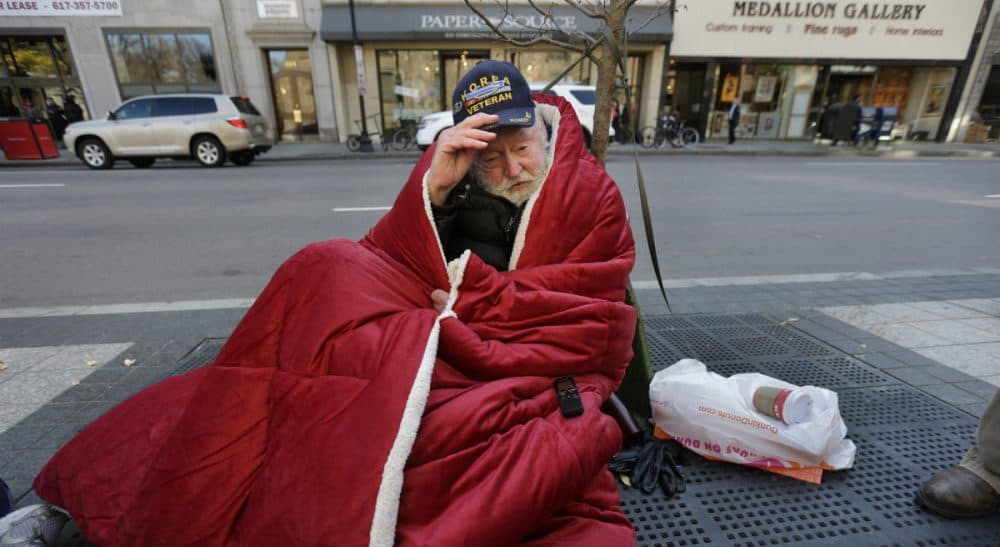Advertisement
Homelessness In Boston, 1 Year After Losing The Long Island Shelter

A year ago today, at 3 p.m., following a private inspection and consultation with the Massachusetts Department of Transportation, the city of Boston closed the Long Island Bridge. The rusty, 63-year-old structure was the only access point to the Boston Harbor island. When it closed, so did the city’s largest homeless shelter (450 beds); its largest detox center (60 beds); and a several other social programs designed to help the homeless or those battling addiction. The city gave those who worked and received services on the island three hours to leave it.
The rusty, 63-year-old [Long Island Bridge] was the only access point to the island. When it closed, so did the city’s largest homeless shelter.
The struggle to shelter the hundreds displaced -- “Long Island refugees,” some advocates labeled them — was immediate and overwhelming. Men vied for one of 200 makeshift beds and 50 cots on the hastily transformed basketball court at the South End Fitness Center. Women contended with overcrowding at Barbara McInnis House and St. Francis House. It was not until last June that the new Southampton Shelter, designated to replace the one that closed on the island, had the promised 400+ beds in place. Renovations are ongoing at Southampton, which is open 24 hours a day and accepts people at any hour as long as a bed is available.

Alarmed by the problem that the Long Island shelter closure brought into such sharp relief, Mayor Marty Walsh laid out a plan to end homelessness in Boston by 2018. The plan calls for, among other strategies, a housing first model, which gives the chronically homeless (those who spend years in emergency shelters) homes as quickly as possible. There is reason for hope: Since its implementation in 2005, housing first reduced chronic homelessness in Utah by 91 percent.
Walsh's plan also calls for coordinated access, a centralized online database that matches homeless individuals to appropriate housing and program vacancies, matching those with disabilities to assisted living, for example. This approach enabled Ohio's Dayton-Montgomery County to reduce its homeless population by 9 percent between 2010 and 2011. The success rate was even larger for homeless families: a 12 percent reduction.
These are steps in the right direction, but questions remain. Among them: How will the city find and secure available housing units? How will a coordinated access system navigate the often conflicting requirements and rules of city, state, federal and nonprofit agencies, not to mention privacy laws?
There are still options to consider at the shelter level, too. After New York City established low-restriction “safe haven” alternatives to shelters in 2005, the number of long-term shelter residents dropped from 1,400 to 630 just four years later. At such shelters, clients come and go, have no curfew and are allowed in regardless of their sobriety or intoxication. With winter approaching, such low-threshold alternatives could encourage more homeless to seek professionally run locations rather than crashing at MBTA stations, camping in tents or even building igloos.
Storage is another critical issue for the homeless, one that didn’t receive much attention until Long Island clients’ belongings were stranded in lockers on the island. It's more than clothes and random personal effects — it's identification documents, medical records and other vital information. (Southampton has only 250 lockers at the moment.)
Asking the homeless what they need and want in the shelter experience is also key. One Spare Change News vendor told me he wished Southampton had a quiet reading room and a computer lab in which to relax, study and look for work and additional forms of assistance.
It is time to view homelessness as a systemic issue. It is not about individual failures... It will not be solved through charity.
It is time to view homelessness as a systemic issue. It is not about individual failures (i.e., they did something wrong to end up on the streets). It will not be solved through charity (i.e., donations of food and clothing). Homelessness, as Boston’s legendary street doctor Jim O’Connell told me, is a symptom of failures in various systems: education, criminal justice, health care, economy, housing market.
These are important to factors to consider, especially given the fact that, in the year since the Long Island shelter closed, Boston’s homeless population has grown by 5.6 percent. Family homelessness, a unique challenge in and of itself, increased a staggering 25 percent in the last year.
As Bostonians measure progress and consider solutions to end homelessness, there’s reason to be optimistic. Let's not forget, however, how long a year it was for many of our citizens.
